Spencer Richards in conversation with John Bunker
JB: So, Spencer, I’d like to start by trying to give some context to how your relationship with Frank has developed. Could you talk a little about how you first met Frank and take it from there?
SR: Well, in 1994 a friend of mine, Skoto, had a gallery in SoHo, and he was showing Frank’s work. It was a two-man show: Richard Baye, (a Nigerian sculptor) and Frank. I’d known the gallery owner before this because I’d developed an interest in Nigerian art and he travelled there and brought back art and sold it from his premises. Over the years we developed a keen friendship around discussions about art and black art from the motherland and beyond. So, Skoto was going to Frank’s studio to pick the work for this two-man show and he invited me along. I can’t say that at this point in time I really knew Frank’s work. I’d seen it but I didn’t have any solid connection there. Abstract art was, in those days, just that, abstract art- if you know what I mean? It was something else…
JB: Yes, indeed.
SR: So I went along to the studio and met Frank (and Rachel) for the first time- this was the studio in Dumbo. So I met him and we chatted- me, my friend, his wife, Alix, Frank and Rachel. My friend and his wife chose the work they wanted and we left. But just as we were leaving Frank said to me: when are you coming back? Ha, you know both he and I are from Guyana, but he had this reputation of being an artist of the world; and I felt that artists who had that kind of reputation might be a bit standoffish. But no. I went back again. Every time he’d come to New York in the Spring and the Fall I would visit him at the studio nearly every day. We would talk and I’d watch him work.
Now, in those days there was never any hands-on work from me: Frank did everything, the stretching, the stapling, the painting and framing. He did everything, you know?
JB: Do you think your connection was about you both being born and growing up in Guyana? Was that what you talked about together at that time?
SR: Umm, yes and no. There were certain things in common in our lives, like the landscape and things like that. But he had a very different experience of the country. Where we grew up were two different places but there were commonalities that we grooved on, yes. But certainly, it was the attempt to understand his abstraction in terms of what I had been accustomed to as art- that was what was the important thing because I tell you, honest to God, when I looked at the work I thought I’d bitten off more than I could chew, right? I didn’t understand what I was seeing. But the conversation grew, and one of the things about being around Frank is, whether in a gallery or the studio, he never tells you what to think. The thinking is up to you. This is integral to the way he works in the studio. When in 1996 I began working with him or assisting more, he would say do something, and I would be very intimidated because I didn’t want to spoil it. But you learn that whatever happens on the canvas is part of the improvisation.
JB: So Frank is bouncing off of whatever you bring to the surface of the canvas? It’s a kind of challenge to him?
SR: Yes, constantly.
JB: Just lingering on the Guyana connection for a little longer: you said you had a growing interest in art from Africa. Were you looking to start, in your own way, to collect art that might have some connection to Guyana or Africa?
SR: Collect? Ha! I know in 1984 I bought a work by an artist called Lee (Dudley) Charles. I was in Guyana in 1984 and, you know, you usually pick up little trinkets as a tourist. I went to a museum and there was this one painting there and I said, if I had to give this painting a name I’d call it ‘Moon Gazer’ and lo and behold, I went around to the plaque and the name of it was ‘Moon Gazer’, you know what I mean? Moon Gazer is a character from Guyanese folklore- there’s a whole story too long to get into here but I bought it- in American terms it was cheap. I lived with it for a couple of years and that encouraged me to do a lot more reading about art from that part of the world and art in general. I was saying to somebody the other day, I didn’t realise how much it was in my consciousness until a couple of years ago when I went to the Tate, and there was the Ophelia1Sir John Everett Millais, ‘Ophelia’ (1851-52), oil on canvas, 76.2 x 111.8cm picture. Now we used a text book at school called the ‘West Indian Reader’ and that painting was reproduced in it and I think the other one was ‘The Boyhood of Raleigh’2Sir John Everett Millais, ‘The Boyhood of Raleigh’ (1870), oil on canvas, 48 x 56cm – the one where the sailor is pointing out to sea? So it was not such a distant world, it was one that I was born into. You are constantly picking up bits and pieces and connecting dots as it were. I found in Frank’s work it all came together- it had all the stuff that I didn’t know, and the little I did know. Gradually my eye grew into abstraction, and it happened with one piece of work and it was a revelation for both him and me. Its name is ‘Rosignol’3Frank Bowling, ‘Rosignol (Goodbye)’ (2003), acrylic on canvas, 61 x 105cm and it was painted in 1997. As I said, when Frank came over to New York I would visit the studio. So there I am, watching this work progressing. Now, you know how your mind has to certify: if this is this, then that will happen next- you are looking for the logical next step. So I left the studio that night thinking I’ve got this one covered, you know? The next day, I get into the studio and lo and behold, he’d changed it! He’d anticipated where he thought I’d gone with it and he put a twist in it.
Whatever happened then, I still struggle to articulate it. But it has something to do with the name ‘Rosignol’ because he told me that night before I left, that he was going to call this ‘Rosignol’ and I said fine, OK. Now Rosignol is a stelling4A site or position on the shoreline, especially with reference to former Dutch colonies. standing opposite New Amsterdam, where Frank grew up. He was born in Bartica but grew up there. The colours of the painting are rum reds and oranges, evocative of a sunset. Now Frank was always talking about leaving New Amsterdam and going away; there was the story of the trauma of his childhood going on too. Now Rosignol is west, and the colours are that of a sunset. So I said, Frank, you are still in New Amsterdam! Because the only way you would see that scene would be standing on the stelling in New Amsterdam. So we had a great big laugh about that. Afterwards he said it had cleared a lot of things up for him in terms of that narrow place that his work was constantly being put in, with all that stuff about Caribbean colour.
JB: So up until around that time he was always reacting against this pigeonholing: as being seen as a black artist or a Caribbean artist and that this labelling was marginalizing him?
SR: Yes, yes.
JB: But in talking to you, a friend of Guyanese heritage with a shared sense of place- he was bouncing off that connection in the studio? Did it help him uncover these deeper connections with Guyana?
SR: Yes, I think so, but one can only think so and one can only guess about this. It was something in his consciousness that he felt had to be dealt with once and for all because it was a reality of our lives. And all through the years Frank has called pictures after places in Guyana. So gradually, I began to help more in the studio with little tasks. Like, ‘pass that brush’ or something like that. After that, I started coming to London.
JB: So, we’ve talked a little more about what maybe drew you together and how your friendship developed. It’s really interesting to note how your conversations could be bounced around the studio and into the work, in a way. So there is a sense of Frank bringing into the work whoever is there in the studio with him.
SR: Oh yes.
JB: Did you begin to develop a routine in the studio? A way of working? Or was it a more organic process?
SR: Well, it was really organic. The thing about working with Frank is that, say up till 1997 or maybe even 2000, he did everything himself- under Rachel’s watchful eye. (Rachel is Frank’s wife). I think it was after my first visits to London that I began to get involved in stapling and stuff. Of course, as the years went on, he came to New York less and less, so most of the time I would see him working here in London.
JB: So it became a regular pattern to come over here at particular times in the year, just as we are here now, in the summer, maybe?
SR: Yes, I call them the ‘summer intensives’. If you look around the studio now, there are seven pieces of canvas on the go. For two days last week, it was just constant energy flowing to move things about- to shift from one piece of work to the other. So yes, there’s this organic connection between the works. They feed off each other. This one here started out as some scrap that came from behind something over there. I’ve already decided that in this ‘intensive’, it’ll be the piece that paints itself, you know what I mean? There are pieces of canvas laid out under canvases to catch the drips that then get carried some place else.
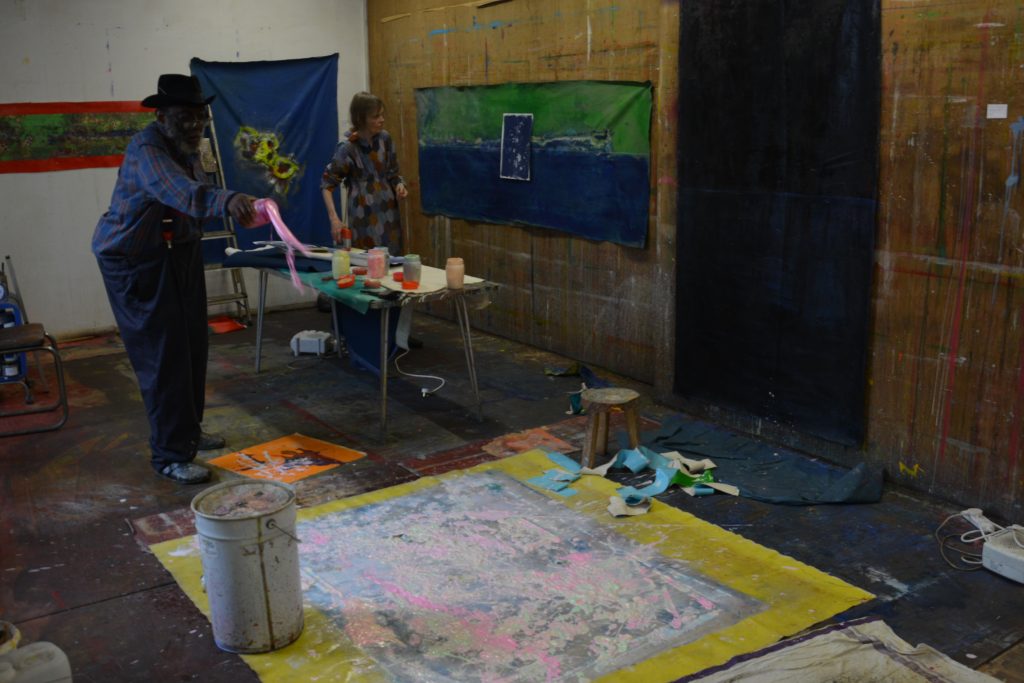
Frank Bowling working in the studio at Peacock Yard with Rachel Scott, 2018. Photo by Spencer Richards
JB:So everything is in a kind of constant flow, on the move around the studio, and they gradually begin to build up layers and layers? So they are all interrelated but then begin to develop their own identities?
SR: Yes, yes, definitely. That chair that your tripod is on is the chair that Frank sits on. And it’s like he is sitting there thinking these pictures out or considering whatever his dreams were the night before. He sits there and you can almost hear his head thinking it out, you know what I mean? And I just get obsessed with what is going to happen next! Not because I want to see a work completed but because I want to see where he’s going to go next with an idea he’s gathered together at this point. So it’s all about what is going to happen next.
JB: I’d like to talk for a moment about how Frank’s work is appreciated in the wider world. Do you think it is seen differently in the US or in other countries from how it might be seen here in the UK? Has the way it has been appreciated changed since you have known him?
SR: Well it has changed because it is being seen more. Earlier in the year it was in Dublin, and before that the Mappa Mundi survey was in Munich. And viewers have had a chance to respond to the work. In terms of appreciation of the work, there was a time up until quite recently when there was more activity in New York in terms of shows than over here. But it was not easy there either, you know? There were times when it was hard to get a dealer to come by to the studio and just look at the work even though he had a reputation forged in the 1960s and 1970s. And it is really gratifying to get all those great works out of storage in New York and send them out into the world and hear the applause for him worldwide. As you know, a lot of your visibility has to do with the Press: they’ve got to write about you. It might be a nuisance to sit and talk with journalists, but it makes a difference.
JB: Do you think there’s been some kind of shift? We are being allowed to see Frank’s work again now: what might the nature of that shift be, do you think?
SR: Well, the art world in general has been looking at the work of artists of colour more seriously recently- that’s one part of it. So Frank benefits from that- just look at ‘Soul of A Nation’ and the publicity it got. It generated new interest for the work, and prior to that, there was the survey show of the ‘Poured Paintings’ at Tate Britain. So, it is visibility again. There wasn’t a lot of print coverage of those shows, to my great disappointment; but that’s how the world works. Appreciation? Well, how do we measure that? Sales? Well, there’s always been sales. Frank has worked from the postage stamp to the billboard-sized painting. I sometimes tease him and say to him you’ll have to buy me a house to put this big-arsed painting in! But medium-sized paintings were always bought, and he did have a steady stream of collectors in New York. The truth is, once the work was up there, then there was interest; if he was in a show, things sold, you know.
JB: Maybe the work of curators has been important. Seeing something in Frank’s work that is unique. Maybe we are witnessing a cultural sea change? We are reassessing Modernism and abstraction….
SR: Well, this goes back to this renewed interest in Black art. A lot of shows- group shows that is- with Frank and his peers, are coming up now. These are museum shows with curators who are doing research and finding real fertile fields here. There’s real scholarship here, and Frank is being mentioned in new narratives about art both here and in the States. So it was a tide that was swelling. As the cliché goes: it’s an idea whose time has come, because in the States it’s not only Frank, it’s Frank and his contemporaries who have been given space on walls.
JB: I’d just like to get back, for a moment, to your own interest in Black art. What were you looking for when you first became interested in collecting?
SR: It took me a little while to realise: I’m a Beaver! I like to collect, you know. I’ve collected records, music, for a long time. Then came the art: and for me, there had to be another reason for getting up and going to work in the morning. I had to have something driving me and that became the thing, like the driving force. So yes, I started collecting. Now Frank has a phrase for it: ‘hightidillyball’? Or something like that. It means a little now and and a little more later…
JB: Oh yes: paying in instalments…
SR: Yes, so I picked up various pieces of African art from the gallery we talked about earlier, and then I met Frank. Thanks to his generosity, he gave me a work of his and then I started collecting more.
JB: Do you think you were making some kind of connection with Africa through this process?
SR: Certainly, yes, because that was what my interest in music was all about. I started with calypso and then moved into jazz and then on to music from all round the world. There’s more of a connection between peoples. You listen to folk music, and there are these similar elements, no matter where it comes from. But it was a spirit I was chasing and still am chasing…
I’d read a book or two books that a poet and and writer, (Thulani Davis) had mentioned in an article in The Village Voice years ago. One book was on Romare Bearden, and the other was on Wilfredo Lam. When I saw Lam’s work, I said well, yes, this is home, you know what I mean? This is family, yes? And I decided if I had the financial wherewithal I would start collecting art of the diaspora as such, because it is a spirit I am chasing, cut off as one is by this unscheduled vacation before grandparents or whoever- even though, somewhere, there are copious records because that’s how colonialism works. Somewhere there maybe secrets to lineage but in the interim I have made up this thing, this connection, this common spirit of expression running through Black people.
But it is interesting, thinking about Frank and his embrace of Modernism and the Western tradition. Guyana achieved independence in 1966: there was a feeling that after so many years of colonial rule, well, here we are, we’ve got our own flag. Also there was West Indian cricket in the ascendancy. It felt like we were starting to get a sense of being on equal footing with the rest of the world. And here was one of our sons who had embraced all that and bettered it, you know. But overarching all this was this sense of there being no recognition for it. I used to go to the Tate and get so depressed. I’d move through the rooms of British art and just when you would expect to see Frank amongst his contemporaries, he wasn’t there. They threw him overboard, you know? It called to mind Turner’s painting of the ship Zong5J.M.W. Turner, ‘The Slave Ship’, (originally titled ‘Slavers Throwing overboard the Dead and Dying—Typhoon coming on’) (1840), oil on canvas, 91 x 123cm, you know- the throwing of the slaves overboard. So I’d go and sit on the steps facing Milbank and fret and fret. Then one year I went back and there was ‘Mirror’! Right among his peers- and not only him, there were other artists from the Commonwealth who lived and worked here, like Aubrey Williams and Rasheed Araeen, and more. So there has become less of a need for me to bitch about things and more of a need to embrace all that modern art has to offer.
A lot of this was in Frank’s writings for Art News, about the state of things as they were.
JB: Yes, absolutely fascinating! So passionate yet such clarity and precision of thought. He so eloquently lays out the positions and arguments about how Black artists might see their place in the trajectories of modern art and Modernism. He understood how these labels were being applied to him and his peers. He talked about how one was supposed to deal with those labels, like ‘Black art’ or ‘Black artist’ or ‘Caribbean artist’. It is something he has wrestled with throughout his career…
SR: Yes, and ultimately he has achieved success on his own terms. You know the shenanigans go on behind the scenes about who gets noticed.
JB: Yes, and as you have so eloquently put it, we have seen the changes at Tate that have happened concerning ‘visibility’. So how do you feel about Frank finally receiving a full retrospective next year at Tate Britain? What does it mean to you?
SR: It means everything. It means not so much that he has arrived- but more a sense of him receiving recognition due. Put it up there and let the public judge, because they are the final arbiter. Sometimes journalists come with their baggage- the usual stuff. But it will be intriguing to see room after room of this artist’s work, his progression from figurative painting to gradually taking on abstraction. Sometimes it might seem difficult to reconcile one style with another- like, is it the same artist? It will be interesting to see things from the corner of one’s eye, to catch and recognise the mark-making of his hand. When I first met Frank, the work was more about collage and marouflage6 Marouflage is a technique for affixing a painted canvas to a wall to be used as a mural, using an adhesive that hardens as it dries, such as plaster or cement. bringing disparate things together to make a whole. In recollection, when I first came on board things were relatively flat. When he worked figuratively he used sand and beeswax to build up texture on the surface, but then that receded, in the stains of the maps, say. But that dynamic is played out in the studio in every session that I’m here. For instance, over here we have this piece of canvas with all that stuff on it yet here there is a large piece that is relatively flat. It is all in play as push-pull, but he is taking push-pull in a different direction.
JB: So he is bringing all these different aspects of Modernist painting together?
SR: And at the same time doing these kind of atavistic grabbings. There is a painting, the first one that I truly fell in love with, that I pulled out while I was looking after the studio when Frank was out of Brooklyn. It was called ‘Thank You Graham Mileson’. It had reds and golds and stuff like that. But the thing that struck me about it- but not immediately as I just really liked the painting- was this particular aspect of the surface. It looked like beaten gold, like the old Ashanti way of beating gold so that colour kind of sat in the surface. And this is one example, in my estimation, that connects an African thing to his current work. It’s an element that many of his contemporaries didn’t have. Your consciousness is bound by what you are taught by rote, but there’s this other business going on in the back of your head, you know?
JB: Frank’s art education was very British….
SR: And that is the amazing thing, and what makes him so unique. His whole consciousness of making art was formed in British art schools just like any other English kid or young fella going to school. Most other artists from Guyana who came here were just finessing their style or skills; but when Frank came here his art consciousness was a tabula rasa, so he went with it you know?
JB: But over the years you feel as though he’s bringing in this other kind of history?
SR: Well you know, it’s always been there. There is a painting called the ‘The Four Horsemen of the Apocalypse’. It’s filled up with heads, screaming heads that are out of Bacon, but they’re also filled up with African masks. The four horsemen are abstracted, it’s not just a scenic rendition, there’s limbs here and limbs there. So I think he has always had that consciousness. He told me he’d spent time working at the British Museum, where he was seeing those masks and all the other stuff .
JB: But he also seems very sensitive to a very wide range of art influences. He seems able to take what he wants from, say, American post-painterly abstraction, or the brute materiality of postwar collage, and reinvent them for himself.
SR: Yes, and the beautiful thing is that it doesn’t sit like oil on water, it all feels totally integrated. I think this is the singular gift that he has.
JB: Is there any particular aspect of the coming retrospective that you are looking forward to?
SR: Well there’s the stamp of approval, for want of a better term, that a retrospective at Tate gives. Over the years I’ve been aware that his contemporaries may have had two or three retrospectives and Frank has not had that full retrospective. So now I’m thinking about being there at the studio on the day he got the call saying that he had been elected as a Royal Academician. Of course he didn’t want to answer the phone because he was at the wall painting and Rachel said Michael Sandle wants to talk to you. So he goes over to the phone, says a few words, and then turns round and says they’ve just made me an Academician. But there was a glow in his face- I don’t know if it was about recognition or what, because it had been a long struggle, as he had been proposed before and been turned down and due to internal politics it didn’t happen. So I wonder why a retrospective didn’t turn up before now. And in the literature and the writing about the art of this period, around the time before Frank became an RA and then, after that, writers would write but Frank’s name wouldn’t be there; and it’s not as though they didn’t know him. I don’t want to mention names of writers, but in the history of 1980s and 1990s art there is no mention of Frank. One could say he spent time in New York but that’s rubbish, you know what I mean? So there’s this benign neglect. But having said all that, this retrospective is not only gratifying to me because he is from Guyana- to use a colloquial expression ‘ah wee boy, you go for it Frank!’– but besides that, it is deeply gratifying that it’s happening but even more gratifying that he is alive to see it in spite of illness and the ups and downs of his life. And none of that has ever stopped him from painting and pushing on and going to the edge.
3 thoughts on “Spencer Richards in conversation with John Bunker”
Comments are closed.
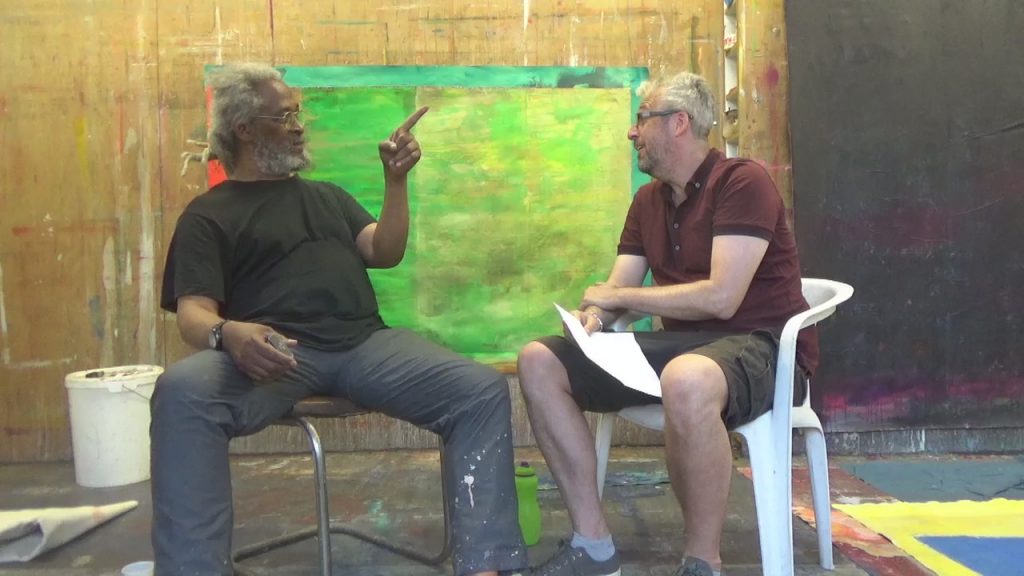
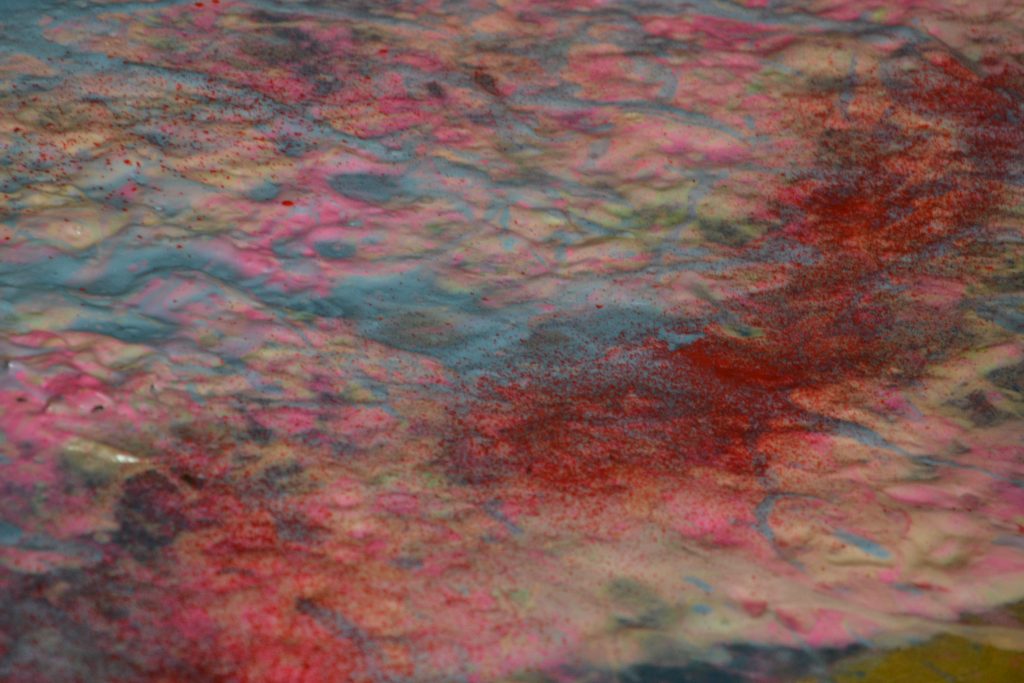

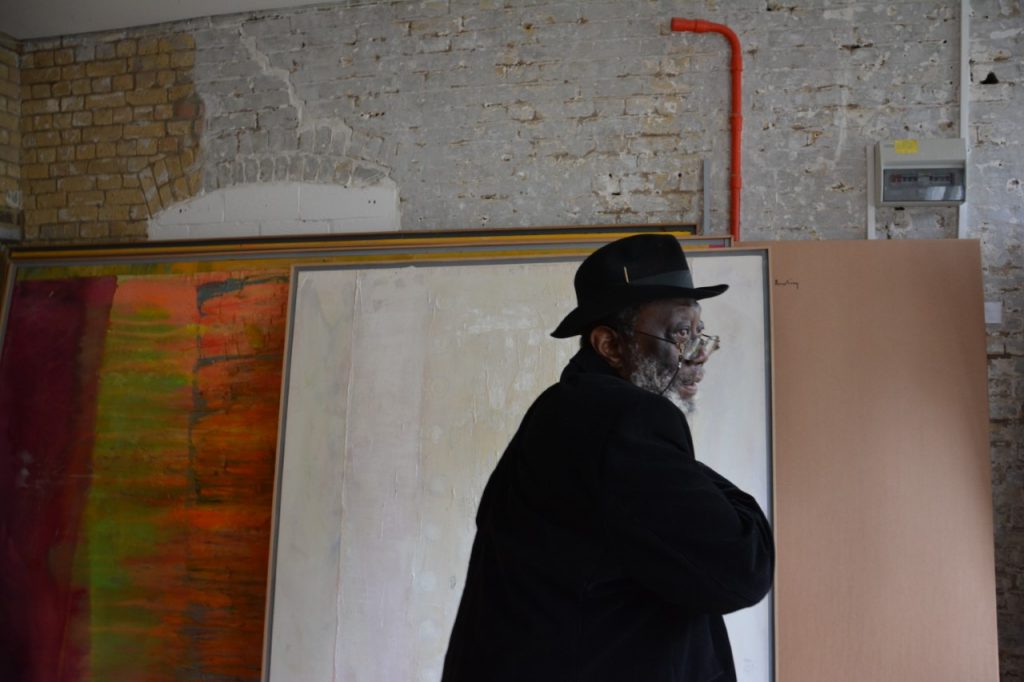
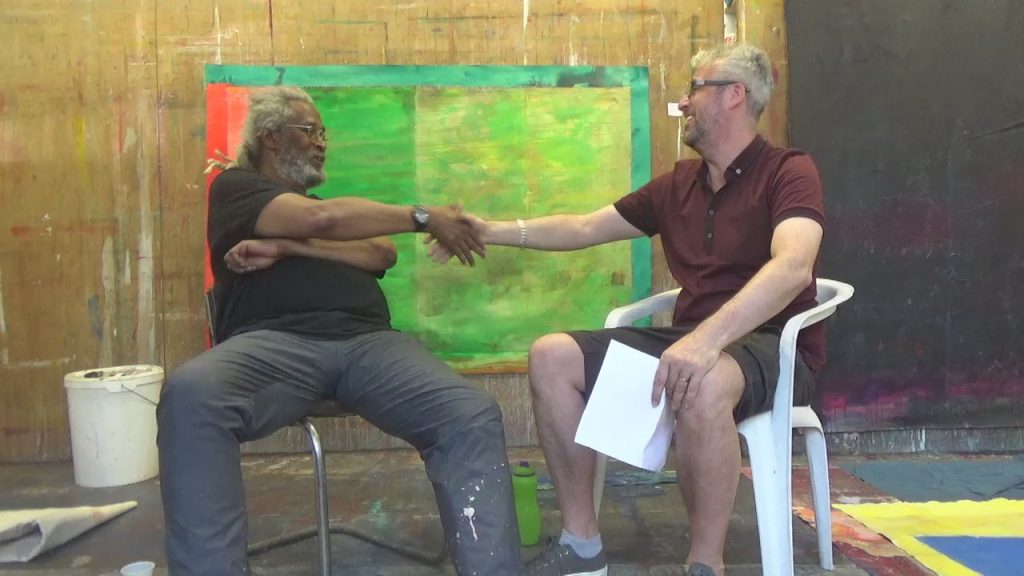
Nice one John, it reads and looks great no?
I think there is a really interesting article to be written on Bowling and collaboration. Might look at the role of chance; how personality contained in paint; action painting; poured (dripped, flung etc) paint; cropping & collage….
A very interesting conversation indeed and wonderfully done.